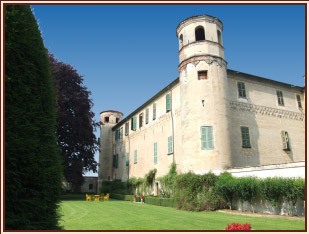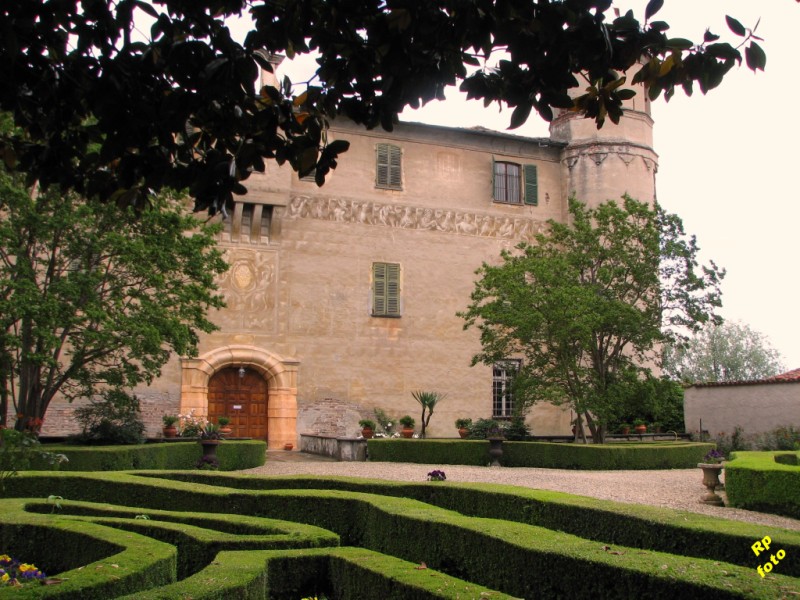 By Stratford Caldecott I recently had the pleasure of attending a Tolkien conference in northern Italy. I say conference, but it was more of a fantasy festival, and most people wore costumes. I dressed in a borrowed Franciscan habit as Gandalf's friend, the wizard Radagast the Brown, and it was in that costume that I was introduced to the Bishop of Piedmont as "a Professor from Oxford" when he came to open the proceedings.
By Stratford Caldecott I recently had the pleasure of attending a Tolkien conference in northern Italy. I say conference, but it was more of a fantasy festival, and most people wore costumes. I dressed in a borrowed Franciscan habit as Gandalf's friend, the wizard Radagast the Brown, and it was in that costume that I was introduced to the Bishop of Piedmont as "a Professor from Oxford" when he came to open the proceedings.With the Alps looming in the background under a dazzling blue sky, we met in the gardens of the 15th century castle of the Counts of Osasco, and the talks - on the theme of "friendship" in The Lord of the Rings - were held under a giant copper beech, reminiscent of the Party Tree where Bilbo put on the Ring and disappeared from the Shire. Speakers incuded three of the young actor-celebrities who dub the voices of Frodo, Aragorn, etc. (as well as Harry Potter) in the Italian versions of the big movies.
But although a lot of people came to the talks (I noticed Sauron lurking in the back during mine), most were there for horse riding, sword fights and training, music and dance, demonstrations of falconry, and for the costume competition. There was a band playing songs from their rock opera of the "Ley of Lethian", and the little kiddies had an arts and crafts section in a replica of Bag End, under the supervision of a comely Elf-maiden. (The grounds had been turned into a map of Middle-earth, so that the horses were in a section called "Edoras", restful cushions in the "Lothlorien" pavilion, and refreshments at the "Prancing Pony".) In other words, it was enormous fun for everyone.
 But what has this to do with the "Way of Beauty"? It should be obvious. What lured people to this event was beauty -- not just the beauty of the setting, but the beauty of the story, and the beauty of the arts and crafts that the film (in particular) inspires us to revive. They were drawn by the elegance of "medieval" costume and courtesy -- exemplified by the young Count of Osaco himself, who hosted the event and served the tables in person. But the beauty of the story comes from two sources: from nature, and from the supernatural.
But what has this to do with the "Way of Beauty"? It should be obvious. What lured people to this event was beauty -- not just the beauty of the setting, but the beauty of the story, and the beauty of the arts and crafts that the film (in particular) inspires us to revive. They were drawn by the elegance of "medieval" costume and courtesy -- exemplified by the young Count of Osaco himself, who hosted the event and served the tables in person. But the beauty of the story comes from two sources: from nature, and from the supernatural.
Tolkien himself wrote that his own "small perception of beauty both in majesty and simplicity" is founded upon Our Lady, and it is clear that the virtues of his characters are illustrations of Christian ethics. Majesty and simplicity: both are paradoxically combined in the Virgin Mary, who is echoed in the story by Galadriel and her patron Elbereth. Sam describes the former as “Proud and far-off as a snow-mountain, and as merry as any lass I ever saw with daisies in her hair in springtime.” The loveliness of mountains and forests, of caves, and country walks in the Shire, of vast plains of grass, and the remote stars, the sounds of the ocean and the crying of the gulls, these are all part of the magic of Middle-earth, the reason we keep going back to it.
 The providence and grace that breathes through Tolkien's cosmos have helped to draw many souls back to faith. Tolkien embodied his understanding of "aesthetics" in the Elves, and it has deep roots in both theology and metaphysics. The organisers of the conference knew this, even if some of the visitors didn't, and as we celebrated Mass in the open courtyard of the Castle in the Italian sunshine, I felt Tolkien would have been happy that his work was still leading people to Christ via the Way of Beauty. -- SC
The providence and grace that breathes through Tolkien's cosmos have helped to draw many souls back to faith. Tolkien embodied his understanding of "aesthetics" in the Elves, and it has deep roots in both theology and metaphysics. The organisers of the conference knew this, even if some of the visitors didn't, and as we celebrated Mass in the open courtyard of the Castle in the Italian sunshine, I felt Tolkien would have been happy that his work was still leading people to Christ via the Way of Beauty. -- SC
Stratford Caldecott is an internationally recognised expert on Tolkein. He is author of the book The Power of the Ring (about the religious and spiritual underpinning of the Lord of the Rings). He is one of the British editors of the journal of faith and culture Second Spring; and is a director of Thomas More College of Liberal Arts’ Center for Faith and Culture; and of the annual Oxford Studies Program for TMC’s undergraduates.
Below: Zurbaran's 17th century painting of Radagast the Brown. Other images are of the Castello di Osasco



